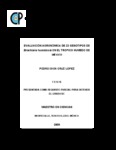Evaluación agronómica de 23 genotipos de Brachiaria humidicola en el trópico húmedo de México
Abstract
En la región tropical de México, donde la producción bovina se basa en sistemas
extensivos bajo condiciones de pastoreo, los pastos del genero Brachiaria han sido de
gran importancia debido a su alto rango de adaptación, mayor rendimiento y calidad
nutricional. El objetivo del presente estudio fue evaluar el rendimiento total, composición
morfológica, tasa de crecimiento, densidad de tallos y dinámica de ahijamiento de 23
genotipos de Brachiaria humidicola y un hibrido. El estudio se realizó de junio 2006 a
mayo de 2007 en el Sitio Experimental “Papaloapan”, ubicado en Isla Veracruz. Los
tratamientos fueron los 23 genotipos y un hibrido (evaluados cada 28 en la época de
lluvias y 42 días en la época de nortes y seca) distribuidos aleatoriamente en un diseño
de bloques al azar con tres repeticiones. En rendimiento total existieron diferencias
significativas (P!0.05) mostrando el mayor rendimiento el genotipo 679 cv. chetumal
(17, 353 kg MS ha-1) y el menor rendimiento el genotipo 26159 (11 104 kg MS ha-1). La
distribución estacional del rendimiento total promedio de los 24 genotipos fue de 83%
en lluvias, 9% en nortes y 8% en la época seca. La mayor TC se presento en el mes de
junio con un promedio de 189 kg MS ha-1 d-1, reduciendo gradualmente hasta los 4 kg
MS ha-1 d-1 en el mes de mayo. El componente con mayor contribución al rendimiento
fue el porcentaje de hojas y la tendencia se presento en orden descendente (P!0.05):
nortes > seca > lluvias, con promedios de 77.6, 71.7 y 57.6% respectivamente. La
densidad de tallos mostro un efecto inverso con respecto a la precipitación, registrando
las mayores densidades en las épocas de seca y nortes. Así mismo, al aumentar la
densidad de tallos se registró una disminución en el peso individual de tallos.________v
In the tropical region of México, where the animal production is based in grazing
systems, the grasses of Brachiaria genus there have been of great importance due to its
high adaptation, higher herbage yield and nutritive value. The aim of this trial was to
evaluate herbage yield, morphological composition, growth rate and tiller population
density of 23 genotypes of Brachiaria humidicola and one hybrid. The study was carried
out from June 2006 to May 2007, at the “Papaloapan” research site (INIFAP), located in
Isla Veracruz. Treatments consisted of 23 genotypes and one hybrid, harvested every
28 days during the rainy season and 42 days during the dry and north’s seasons. The
genotypes were allocated in a completely randomized block design with three replicates.
There were significant differences in total herbage yield (P!0.05), being the genotypes
679 cv. chetumal and 26159 with 17, 353 and 11, 104 kg DM ha-1 how has the highest
and lowest herbage yield. The average herbage yield seasonal distribution of the 24
genotypes was 83, 9 and 8 % during the rainy, north’s and dry seasons, respectively.
The highest average growth rate was recorded on June with 189 kg DM ha-1 d-1,
gradually decreasing to 4 DM ha-1 d-1 on May. Leaves percentage had the highest
contribution to herbage yield and the tendency was: north’s > dry > rainy with an
average of 77.6, 71.7 y 57.6%, respectively. Tiller population density was higher during
the dry and north seasons compared with the rainy season. Also, as tiller population
density increased tiller weight decreased.
Collections
- Tesis MC, MT, MP y DC [403]


